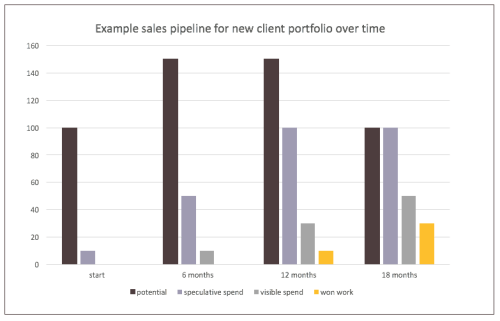How to create a pipeline of new work via your network
Recently I have been having a similar conversation with my clients who are in the process of building up a pipeline of new work and their client portfolio via their network. Therefore, in this blog post I will share the conversation I had with my clients and the secret to building up your own pipeline of work using your network.
What is the reality when you meet someone at a networking event or have a ‘chat’?

So, if you can’t win work just from meeting people, how do you win work?
To answer this question it is good to look at your sales pipeline. Or in other words, how near to buying a prospect is. Within your sales pipeline you are going to have the following categories: Potential: These are people who are the right sort of people to need your services, but you have no idea whether they need your services. You can’t really class these people in your pipeline of new work. Speculative spend: This is when you have a prospect or client where they have a need which you know you can help them with. However, you don’t know their priorities and how likely they are to engage you (or others) to help solve their need. At this stage the prospect could be categorised as a lead, but probably a cold lead. You are likely to be having early stage business development meetings with the prospect. Visible spend: This is when you have an identified need with a client who are motivated to buy and you are having conversations with them about this need. You will have qualified this lead and taken a decision to actively pursue the opportunity. Your prospect is now a warm lead. At this stage you could be in the process of submitting a proposal or a tender. To get people to buy they need to go through all three stages before they will buy.
How do I use my network to get people into potential and then through to visible spend?
Use external introducers
One of the best ways to get people into speculative spend is via intermediaries and referrals to you. This is because the referral is normally indicative that the individual has a need which you can solve. I.e. you pretty much bypass the ‘potential’ stage. The best type of introducer is someone who is spending a significant proportion of their time with your ideal client. All too often I see people building introducer relationships which don’t deliver for 3 main reasons:
- The relationship never gets strong enough for referrals to be made
- The introducer isn’t well positioned to make the right type of referrals to you
- You don’t keep top-of-mind well enough with your introducers to get the referral when it being made
If your network is not yet generating the right type of referrals you need to ask yourself whether you have got a strong enough relationship with your current introducers. Then, whether they are able to send you enough of the referrals you want and need. Takeaway: To get more new business meetings, i.e. ‘potential’ in your diary spend more time deepening relationships and building your visibility with well-placed external introducers.
Use internal introducers
When you are in a big firm you have the luxury of long term client relationships. These long term client relationships are likely to be the best chance of you generating new business and getting your client portfolio started. However, before you can do this you need to get the client account team on side. This means you need to spend time with the client account teams to educate them on your proposition and see whether there is potential speculative spend within the client. Bear in mind that the relationship lead for a client may being bombarded by other people like you with a great proposition to put to their client. Your proposition needs to stand out and be strong enough to be prioritised by the client account team. Takeaway: To generate work from existing clients you first need to educate the account lead on the value of your proposition both to the firm AND the end client.
Go direct to the client
Whilst there are many good reasons why you may want to use internal and external introducers to help you build up your client portfolio, there is no reason why you can’t go direct to the client. Remember you are not selling, you are helping the client buy. The more time you can spend with ‘potentials’, i.e. at conferences/events, online, the easier it is for them to get in touch with you when they need you. But what if you have an identified prospect list of people you want to meet? You still can go direct. The best way is to get a good quality introduction to a decision maker at your prospect. Once again your network can help with this. Which of your introducers knows the key decision maker and can make the introduction for you? Remember, that using this approach is no guarantee that you will identify some speculative spend. These are just ‘potential. Takeaway: Going direct is not about selling, but getting introduced into prospects to help them buy
How to progress the prospects through your pipeline?

It’s a numbers game
Yes, the reality of building up your client portfolio is it is a numbers game. You need to be continually spending time getting people into the ‘potential’ category either through networking directly with them building your profile with them, or spending time with introducers to get introduced or referred to them. To maintain a healthy pipeline of new work means a consistent focus on getting people into the ‘potential’ category. It needs to become part and parcel of what you do on a day-to-day basis.
Where should I focus my attention on my pipeline?
Over time if you are doing the right things you will see the visible and speculative spend build up, and then hopefully convert. If you sell a very high priced service then the sales cycle could be years rather than months. Of course, you always want to spend proportionally more time with the visible spend, followed by the speculative spend then the potentials. But, as mentioned earlier, don’t stop getting people into potential, as this will lead to a gap in your pipeline at some point in the future. When you see work is converting then you can reduce your focus on getting potential, or prospects, into your sales pipeline.








